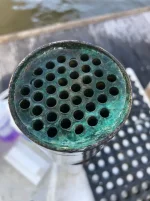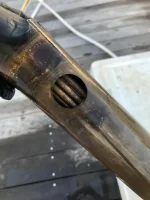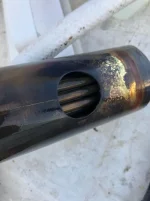racclarkson@gmail.com
Legendary Member
- Joined
- Aug 6, 2015
- Messages
- 3,722
- Status
- OWNER - I own a Hatteras Yacht
- Hatteras Model
- 55' CONV -Series I (1979 - 1988)
As part of my hurricane evac prep, I expediting my generator servicing. To wit, I pulled the HE core on my genset for a dip in phosphoric acid. The raw water tubes were in pretty good shape. That was good news as the tubes are a tiny bit too small to take a .22 caliber cleaning rod. Though it appears there might be some separation in the picture, those are just shadows.

The surprise was there was no water pass through on the coolant side through the pictured openings. When I say no water, I mean none.


The generator has never showed signs of running hot either. The drained coolant condition appeared perfect. So the hour soak for the raw side opened up the flow on the fresh side.
The take away is this: The NL manual's procedure for cleaning the HE bundle is to rod it. Had I been able to do that, I may never have never caught the blockage on the coolant side. There is no mention of that possibility in the book.
I have some Penray 2010 and 2011 on order to give my motors a good coolant side cleaning. Looks like I'll run some of that product through the NL to ensure everything is free flowing.

The surprise was there was no water pass through on the coolant side through the pictured openings. When I say no water, I mean none.


The generator has never showed signs of running hot either. The drained coolant condition appeared perfect. So the hour soak for the raw side opened up the flow on the fresh side.
The take away is this: The NL manual's procedure for cleaning the HE bundle is to rod it. Had I been able to do that, I may never have never caught the blockage on the coolant side. There is no mention of that possibility in the book.
I have some Penray 2010 and 2011 on order to give my motors a good coolant side cleaning. Looks like I'll run some of that product through the NL to ensure everything is free flowing.

